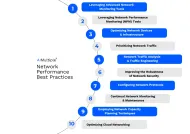IoT Network Management: 3 Strategies for Device Integration in '24


How do you ensure that your Internet of Things (IoT) network remains efficient and secure as it expands? In this guide, we explore effective IoT network management solutions and strategies, from ensuring secure device connectivity to scaling your network safely.
What are the essentials of IoT network management?
Venturing into the IoT domain, we encounter a multitude of choices. The selection of IoT devices and sensors that are reliable, compatible, and adhere to industry standards is fundamental to building a scalable IoT network architecture. But this selection is just the beginning. Smooth operation of these devices necessitates an IoT platform capable of managing device connectivity, multiple communication protocols, and integration with existing business processes. Utilizing device management platforms is essential for seamless functioning and maintenance of the IoT network.
Assessing these IoT platforms is a complex task. It requires a checklist that encompasses:
- Application development
- Maintenance environment
- Data capacity
- User-friendliness
- Cybersecurity
- Scalability
Moreover, to establish internet connectivity, IoT sensors are usually paired with specialized connectivity devices. The beauty of this IoT system arrangement is that these IoT devices can be managed remotely over the internet, thereby allowing oversight and control without physical presence. This ability to remotely track and manage the functioning of distributed IoT devices is facilitated by the IoT network management solutions.
1- Device Provisioning and Onboarding
Provisioning and onboarding constitute the initial pivotal stage in IoT device management. The provisioning process involves configuring a device to connect to a network and the appropriate applications, which includes registration, configuration, and deployment steps. Registration typically involves assigning a unique identity to the device, often in the form of an X.509 certificate. Configuration, on the other hand, includes setting network and security settings, and installing any necessary software updates for the correct operation of the device.
Deployment refers to the physical installation of the device, its power-on sequence, network connection establishment, and initiation of cloud communication. Manual provisioning can be feasible for small batches of devices but does not scale well and is subject to human error. In contrast, over-the-air (OTA) and cloud-based provisioning provide scalability but come with potential security considerations. Striking a balance is vital, cloud-based provisioning that incorporates secure elements and automated strategies can streamline the provisioning process while simultaneously enhancing the network’s security and scalability.
2- Ongoing Software Maintenance
Similar to other systems, IoT devices necessitate recurrent software updates and maintenance for their optimal operation and security. Consumers play a significant role in IoT network security by keeping their IoT devices’ software up to date, securing network routers with strong passwords, and enabling two-factor authentication.
Continuous software maintenance resembles routine health check-ups, acting as a preventive measure against possible risks and vulnerabilities.
3- Fault Management and Troubleshooting
Despite excellent planning and execution, complications may still arise. This is where fault management steps in. Fault management is a crucial component of network management that:
- Detects, isolates, and corrects problems to maintain optimal service delivery
- Provides fault tolerance within IoT networks
- Consistently checks devices’ status, enabling potential real-time issue identification and correction
The fault management process involves several key steps:
- Fault detection
- Fault diagnosis and isolation
- Event correlation and aggregation
- Service restoration
- Problem resolution
Implementing redundancy, such as using redundant sensors, and establishing failover mechanisms are critical for ensuring continuous operation and achieving scalability in IoT networks.
How to scale IoT networks effectively?
As we delve further into the IoT domain, the importance of scalability emerges. A scalable IoT low power network enables the seamless integration of new devices or services while maintaining optimal network performance. This allows for continued expansion without hindering network efficiency. It’s akin to adding more members to a team without affecting the team’s productivity. Recent technological advances such as the development of low power devices are fundamental to the scalability of IoT applications.
Essential requirements for managing IoT low power networks encompass:
- Scalability
- Fault tolerance
- Energy efficiency
- Security to uphold Quality of Service (QoS)
- User satisfaction
There are various existing solutions for managing IoT low power networks. These include network management protocols, SDN-based frameworks, cloud-based frameworks, semantic-based frameworks, and machine learning-based frameworks. Evaluating these platforms encompass scalability, usability, application environment range, connectivity management, security, and data aggregation capabilities.
1- Network Connectivity and Traffic Management
In the IoT sphere, network connectivity and traffic management serve as the heart and blood vessels of the human body, safeguarding the seamless flow of information. Effective IoT network traffic management uses policies to prioritize, limit, or block types of traffic, mitigating congestion and enhancing network performance. This process is enhanced by Software-Defined Networking (SDN), which allows for fine-grained control and dynamic policy updates in real-time based on the current state of network traffic.
In addition, the utilization of Token Bucket algorithms and cooperative traffic management across multiple switches mitigates packet loss and guarantees prioritization of real-time traffic in IoT networks.
Future IoT network traffic management improvements may involve the integration of network devices, such as Graph Neural Networks (GNNs) and Multi-Armed Bandit (MAB) algorithms with SDN.
2- Remote Monitoring and Control Capabilities
The capability to remotely manage and control IoT devices offers a comprehensive view of the entire network. The core components of an IoT remote monitoring system include data acquisition, data analytics, and event notification, with sensors or overlay sensors capturing data for cloud-based analysis. Software known as an ‘agent’ or ‘edge’ captures data from remote assets and securely transfers it to a central repository.
IoT remote monitoring allows for near real-time tracking of various parameters like temperature, pressure, and humidity, remotely accessible via internet-connected devices. Integrating IoT devices with cloud backup solutions and network segmentation enhances network security through continuous monitoring and proactive defense against attacks. These analytics within remote monitoring systems assess core operating parameters and use historical data to identify multivariate issues and trends.
3- Data Collection and Utilization
Data serves as the vital element of any IoT network, and its effective collection and use are imperative for informed decision-making. Cloud computing provides a model for enabling ubiquitous, convenient, on-demand network access, which is essential for managing IoT low power networks. Ensuring synchronization between the cloud and gateways is critical in IoT device management, allowing seamless communication with gateways via the cloud service.
Data aggregation and management in IoT should not only integrate data from various sources but also facilitate real-time insights to enable swift decision-making processes. This efficient data management is akin to having a well-oiled machine that operates smoothly and delivers top-notch performance.
What are some advanced tactics to secure IoT networks?
With a grasp on the complexities of IoT device management, we shift our focus to the paramount aspect of security. Setting up a robust and secure network infrastructure with secure communication protocols minimizes security risks and supports scalability. Without appropriate security measures, even the most well-built IoT networks can rapidly turn into a haven for cybercriminals.
Security in IoT networks is crucial to prevent tampering with communication data and to ensure the exchanged data’s integrity. A thorough security strategy for protecting IoT devices should be comprehensive and regularly reviewed to address the changing landscape of threats effectively. This is particularly important when dealing with IoT devices from various vendors, which can present security and compatibility challenges.
1- Encryption and Secure Wireless Connection
Encryption and secure wireless connections constitute the foundation of IoT network security. Symmetric encryption, like DES and Triple-DES, uses a single key for both encryption and decryption, offering a simple, fast, and power-efficient solution for IoT. On the other hand, Asymmetric encryption and Elliptical Curve Cryptography (ECC) provide enhanced security through authentication, producing shorter and more efficient keys suitable for resource-constrained IoT devices.
The Advanced Encryption Standard (AES) is favored in IoT for its strength and resilience to cyber-attacks, excluding brute-force attacks. Encryption enables data protection at rest, in use, and in motion across varied IoT devices, critical for maintaining network communication security.
Device authentication using certificates during provisioning can enhance communication security by ensuring encrypted data transmission and maintaining data integrity.
2- Access Control and Authorization
Similar to a secure home needing strong locks, an IoT network necessitates stringent access control measures. Access control for IoT networks should include:
- A secure firewall setup
- Deploying security tools like multi-factor authentication (MFA)
- Hardening IoT endpoints by securing high-risk ports
- Protecting devices from malicious code injection
These best practices will help ensure the security of your IoT network.
Role-based access control (RBAC) is increasingly important in IoT networks. It ensures users are granted only the minimum level of access necessary for their roles, which reduces the risk of data breaches. However, there are challenges in encryption key management at an enterprise level, which can lead to restricted data access if encryption keys are lost, thereby impacting access control.
3- AI-Enhanced Network Security
Looking towards the future, artificial intelligence (AI) proves to be a game-changer in IoT network security. Machine learning algorithms can analyze sensor data and network traffic to detect anomalies indicative of cyber threats, while AI monitors system logs and activity to identify known and unknown threats in real-time. AI-powered tools are being used for behavioral analysis and malware detection, crucial for identifying suspicious device activities and zero-day attacks in IoT networks.
Deep learning techniques automatically detect patterns and anomalies in IoT network traffic, and anomaly detection is essential for spotting unusual data transmissions. AI-driven security systems in IoT adapt by learning from network behavior and past incidents, addressing the unique challenges of IoT security. However, challenges such as the need for large datasets and risks of false positives/negatives temper AI’s potential in IoT security.
Performance Monitoring for IoT Systems
IoT network performance monitoring tools:
- Collect data from devices, gateways, and applications
- Perform functions such as performance and equipment monitoring
- Offer features like prompt alerting, visualization, seamless device onboarding, and AI-powered insights
Their function is comparable to the human body’s nervous system, gathering sensory information for the brain to process.
Critical performance metrics monitored by tools include CPU utilization, memory usage, and disk space of IoT devices. These tools monitor traffic utilization and can alert before traffic crosses the bandwidth limit using thresholds for incoming bytes, outgoing bytes, and total byte counts. Monitoring network paths outside the local network is crucial to understand where performance issues may occur and to proactively manage service quality.
1- Real-Time Network Performance Insights
The significance of real-time monitoring is undeniable. Real-time monitoring of IoT networks plays a crucial role in:
- Tracking continuous snapshots of network performance
- Ensuring issues are identified and resolved promptly to prevent operational disruptions
- Real-time alerting and performance monitoring markedly decrease incident response times
- Leading to faster issue mitigation and minimizing potential losses.
Monitoring tools, including network monitoring tools, provide valuable insights into data transfer rates, enabling timely adjustments on bandwidth usage and network latency, which directly improves the performance of IoT applications. Transparent visibility of network usage through real-time monitoring tools facilitates cost savings and supports infrastructure optimization by eliminating unnecessary technology expenditures.
Real-time network monitoring underpins predictive maintenance, enabling immediate responses to network incidents and proactively preventing minor issues from escalating into significant equipment failures.
2- Energy Efficiency and Resource Optimization
Given the current era of climate change, energy efficiency has become more significant than ever. Energy efficiency is a main requirement for IoT low power networks to maximize their network lifetime and prevent loss of connectivity. Lightweight cryptography is emerging as an energy-efficient solution suitable for small IoT products like RFID tags and sensor networks.
3- Equipment Monitoring and Predictive Maintenance
Predictive maintenance serves as the foresight tool in the IoT sphere. IoT predictive maintenance applies IoT technology to collect and analyze data for predicting potential equipment failure or outages in a proactive manner. Predictive maintenance leverages machine learning and algorithms to evaluate asset conditions and inform maintenance schedules.
Historical data and pattern analysis through AI enable prediction of device failures and identification of security vulnerabilities. Adopting IoT remote monitoring for predictive maintenance can result in significant cost reductions, lesser equipment failures, and improved customer satisfaction. Continuous performance monitoring and predictive maintenance via IoT enhance productivity and asset performance over their life cycles, while reducing unplanned downtime.
If you have questions or need help in finding vendors, feel free to reach out:

Cem has been the principal analyst at AIMultiple since 2017. AIMultiple informs hundreds of thousands of businesses (as per similarWeb) including 60% of Fortune 500 every month.
Cem's work has been cited by leading global publications including Business Insider, Forbes, Washington Post, global firms like Deloitte, HPE, NGOs like World Economic Forum and supranational organizations like European Commission. You can see more reputable companies and media that referenced AIMultiple.
Throughout his career, Cem served as a tech consultant, tech buyer and tech entrepreneur. He advised businesses on their enterprise software, automation, cloud, AI / ML and other technology related decisions at McKinsey & Company and Altman Solon for more than a decade. He also published a McKinsey report on digitalization.
He led technology strategy and procurement of a telco while reporting to the CEO. He has also led commercial growth of deep tech company Hypatos that reached a 7 digit annual recurring revenue and a 9 digit valuation from 0 within 2 years. Cem's work in Hypatos was covered by leading technology publications like TechCrunch and Business Insider.
Cem regularly speaks at international technology conferences. He graduated from Bogazici University as a computer engineer and holds an MBA from Columbia Business School.
To stay up-to-date on B2B tech & accelerate your enterprise:
Follow on

Comments
Your email address will not be published. All fields are required.